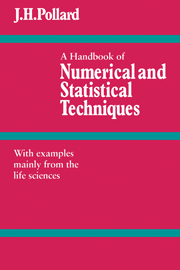Book contents
- Frontmatter
- Contents
- List of statistical and mathematical tables
- Preface
- PART I BASIC NUMERICAL TECHNIQUES
- PART II BASIC STATISTICAL TECHNIQUES
- PART III THE METHOD OF LEAST SQUARES
- 15 Simple linear regression and the method of least squares
- 16 Curvilinear regression
- 17 Multiple linear regression
- 18 Non-linear regression
- Appendix
- References
- Author index
- Subject index
17 - Multiple linear regression
Published online by Cambridge University Press: 18 December 2009
- Frontmatter
- Contents
- List of statistical and mathematical tables
- Preface
- PART I BASIC NUMERICAL TECHNIQUES
- PART II BASIC STATISTICAL TECHNIQUES
- PART III THE METHOD OF LEAST SQUARES
- 15 Simple linear regression and the method of least squares
- 16 Curvilinear regression
- 17 Multiple linear regression
- 18 Non-linear regression
- Appendix
- References
- Author index
- Subject index
Summary
Summary In this chapter, we show how the matrix methods of chapters 15 and 16 can be used to study the regression of a dependent variable y on two or more independent variables. We also discuss briefly the problem of choosing the ‘best’ regression equation.
Introduction and simple examples of multiple regression
In chapters 15 and 16 we described the methods of simple linear regression and curvilinear regression of a dependent variable y on a single independent variable x. The same techniques can be used to study the regression of a dependent variable y on two or more independent variables (x, z, etc.) when the regression equation is linear in the coefficients {bi}. The analysis is then referred to as multiple linear regression. Matrix methods are essential; all the formulae and methods have already been given in the earlier chapters, and references to them are listed in table 17.1.1.
Examples 17.1.1–17.1.5 show how the regression vectors and matrices y, b, X and S are obtained. They also demonstrate the following techniques: the corrected and uncorrected analysis of variance for testing the significance of regression (examples 17.1.1 and 17.1.3), confidence limits for the regression parameters {βi} and σ2 (example 17.1.1), hypothesis-testing (example 17.1.3), confidence limits for the expected value of the dependent variable given the values of the independent variables (example 17.1.2), testing for lack-of-fit (example 17.1.5), and weighted least squares (example 17.1.4).
- Type
- Chapter
- Information
- A Handbook of Numerical and Statistical TechniquesWith Examples Mainly from the Life Sciences, pp. 300 - 312Publisher: Cambridge University PressPrint publication year: 1977



